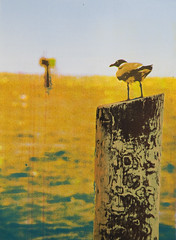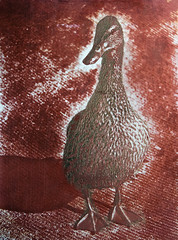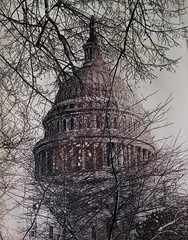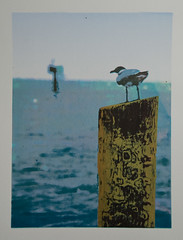 Website: frankpappas.com
Website: frankpappas.comEtsy: notoriousfcp.etsy.com
Flickr: flickr.com/photos/notoriousFCP
BRIEF BIO
I’ve spent the better part of two decades helping companies develop powerful brands, products, and services. I’ve worked with companies like Marriott, Swissair, Land Rover, the Smithsonian, and Seventeen Magazine, helping to grow market share, increase revenue, and adapt to the ever-changing realities of the digital age.
But we all know what they say about "all work and no play..."
In my spare time, I explore a variety of creative pursuits, including cooking, writing, photography, and printmaking. For more than three years, I assisted classically-trained chefs in teaching recreational cooking classes at L'academie de Cuisine in Bethesda, MD. I’ve also co-authored a number of books and articles on topics ranging from online pricing and distribution models in the music industry to business use of technology, contemporary American politics, travel, and product development. For the past few years I’ve worked with artists at Washington's Corcoran College of Art + Design to explore photography, typography and graphic design, printmaking, and drawing.
I’ve earned a BA in Political Science and Spanish Language/Literature from the George Washington University and an MA in Communications from Georgetown University.
HOW DID YOU GET STARTED IN PRINTMAKING?
Almost completely by chance, actually. I’ve worked in advertising for a long time and have been fortunate to work with extremely talented copywriters, designers, producers, and programmers. The bulk of my experience is in creating interactive and print campaigns and products for hospitality, travel, automotive, and consumer products companies in the US and Europe. And while I’ve always been comfortable collaborating with brand managers and market researchers and account executives, I’ve often felt that working with my design teams was harder than it needed to be. I’m not sure if this was due to my lack of hands-on design experience, not sharing the same vocabulary, some fundamental gap between left-brain and right-brain personalities. But as the guy ultimately responsible for the quality of our work, I was determined to find a way to improve my interaction with my designers. My approach was to take classes at the Corcoran College of Art + Design, everything from Photoshop and InDesign to drawing, photography, lighting design for interiors, and graphic design. A few years back I replaced a canceled class with screenprinting and was absolutely amazed by the powerful emotional and physical connection I felt in the studio. The physicality of the process, infinite opportunities to follow traditional techniques or to experiment with new approaches, the joy of creating multiples, it all had me hooked right from the start.

DESCRIBE WHERE YOU WORK
The bulk of my printing happens in the print studio at the Corcoran, which is in the basement of a really old, former public school building in DC. It’s a great space to learn the basics. It’s on the smaller side, so you learn quickly how to work in close quarters with other printers, how to move carefully between printers as you carry your prints to the rack, how to be aware of those moving around you with prints or pots of ink or the random sharp, pointy object. Our equipment is anything but fancy – wood and aluminum screens clamped to work tables – no cool vacuum tables or anything like that. And it certainly isn’t new – our racks and floors and tables and washout room are layered with spots and smears of ink, scratches, rust, dents – a subtle reminder that there’s history all around us, the collective creativity and sweat and effort of all the students and masters who’ve printed before us. That makes the space inspiring, and as cramped and frustrating as it can be, it feels like home.
WHAT IS YOUR FAVORITE PRINTMAKING PROCESS?
Screenprinting, definitely. I studied intaglio many years ago with master printer Scip Barnhart, which was really a great experience. But as much as I enjoyed the process, it's so much slower than screenprinting. And much more dependent on my ability to draw, which is probably one of my least-developed skills. So while I enjoy it, most of my intaglio work would probably be stick figures interacting with other stick figures.
Screenprinting, on the other hand, well, that’s a whole different ballgame. My creative process for screenprinting is fueled in so many ways by my photography, through abstract designs or compositions in Photoshop or Illustrator, or more traditionally through non-digital processes. I’m able to envision and create much more effectively – and I think at a higher level – through screenprinting than I would with any other process.
WHAT'S YOUR CREATIVE PROCESS FOR ANY GIVEN PRINT? (EG. SKETCH FIRST? PRE-PLANNED OR FREE-FORM?)
My best prints - or at least the ones I feel are the most successful - start out from my photographs. I try to travel to interesting places, though recently (thanks, economy!) those places have been much closer to home. Places like Philadelphia, shooting well-known but very interesting places like Eastern State Penitentiary or Smith Island, Maryland, which is home of the many-layered Smith Island Cake. I’ll even drive for hours and hours to places like Centralia, PA, which is what’s left of an entire town destroyed by a coal mine fire. Places with history, with a unique story, with some kind of beauty and meaning. I then pull everything into Photoshop or Illustrator to experiment with texture, tone, balance, all the little tweaks needed to pull together an exciting composition. Sometimes there’s a lot of manipulation involved, as with my print “El Gran Gallo,” where the original photograph is substantially transformed into a graphic print. Other times the digital work is very minimal, as with “Gull,” where Photoshop was used merely to create CMYK separations, the print clearly reflecting its photographic origins. Finally, it's into the studio, where I try to challenge myself with each new project, working with new color palettes, techniques that are new and unusual, or sizes or aspect ratios that I haven't worked with before.
WHAT DO YOU ENJOY MOST ABOUT PRINTMAKING?
The night before I go into the studio I'll spend some time doing a mental walk-through of my battle plan, about everything that needs to be done, about the best timing, order, where things can go wrong. I try to anticipate problems and how to keep them from happening. So by the time I get into the studio, I have a fairly good idea of what needs to happen, when, and how I can act and react if anything funky happens.
What I love about printmaking, then, is when I get into the studio and the day unfolds much like I've visualized it. I'm in the zone, everything is breaking my way. My film looks just like I want it, the emulsion isn't too old and is holding the detail of my images nicely. There's plenty of room to work, I'm getting my inks together without much hassle. And when the printing begins, it's almost on automatic, pour, flood, drop, pull, lift, flood, repeat. I spin gingerly on one foot and carry my prints to the rack, the other printers in the studio moving deftly aside as I scoot by. There's a harmony, a synchronicity between us. My head's down, I'm doing good work, the rhythm and pacing are spot on. Can’t get enough of that feeling.
WHAT'S YOUR LEAST FAVORITE PART OF THE PROCESS?
I hate picking colors for my prints. I am woefully unschooled in color theory, though I do generally know a good color combination when I see one. But my knowledge and skill in this area are very rough, unrefined. I’m certainly not delicate when it comes to color, and often default to bold colors because I just don’t trust myself outside of this comfort zone. I've been aching to take a color theory class for years, but haven’t had any luck so far. Fortunately my instructors Manuel Navarette and Carolyn Hartmann have been extremely gracious in sharing little color theory insights with me, suggesting better combinations or directions for particular projects. But I'd very much like to take color theory so I can embrace this part of the process more fully, make it more my own.
WHAT ARE YOUR INSPIRATIONS (OTHER ARTISTS, PEOPLE, PLACES, EVENTS, ETC.)?
In the last 15 years or so, there are three artists who have really inspired me to embrace artistic pursuits. First is Scip Barnhart, my intaglio instructor, who gave me my first taste of the technical skill and creative processes required to create something meaningful, beautiful, fulfilling. More recently are two New Orleans artists, Matt Rinard and Robert Guthrie. I've been collecting their work for years and have been surrounded at home by their prints and originals and bits of sculpture. Each time I catch a glimpse of their work, some little emotional part of me thinks fondly of New Orleans and an overwhelming sense of happiness washes over me. Let me make it clear that I'm absolutely in no way comparing my work to the awesomeness these guys create, but knowing how happy their art makes me, I thought it would be really, amazingly cool to see if I could find something within me, some creativity, some passion, that could give a bit of that happiness to others. And it goes without saying that I’d be absolutely nowhere in any of this without the attention, support, and dedication of my instructors Carolyn and Manuel.
HOW HAS YOUR WORK CHANGED AND EVOLVED SINCE YOU STARTED?
It’s important to understand that when I walked into the studio that very first day, I had absolutely no idea what I was getting into. None. Yeah, I’d had that intaglio experience with Scip years earlier, but wow, such a different process, different tools, different mindset. So I was really starting from scratch. My first year or so was spent focused on the basics, developing the muscle memory of the right way to pull the squeegee across my screen, developing a fluidity of movement in my personal printing process, becoming familiar with the temperament of the inks and acrylic base, how they change based on environmental circumstances, how to coax them into doing what I want them to do with a little bit of airbrush cleaner. My prints in this time were very traditional, straightforward examples, pretty much just ink on paper.
 But throughout that first year, I did two important things. First, I asked questions, a lot of questions. I’m sure I drove my instructors a little nuts. Second, I searched bookstores and galleries and the internet for more information on screenprinting, but also generally about all types of printmaking. So over the course of that year, I learned, for example, about metallic powders and glass beads and mecoflock and the use of adhesives. I learned about very interesting techniques using wax and oil paint to add depth and dimension to my prints. I discovered how important it can be to pick the right paper for an edition, because some papers simply won’t accommodate an artist’s vision for a particular project.
But throughout that first year, I did two important things. First, I asked questions, a lot of questions. I’m sure I drove my instructors a little nuts. Second, I searched bookstores and galleries and the internet for more information on screenprinting, but also generally about all types of printmaking. So over the course of that year, I learned, for example, about metallic powders and glass beads and mecoflock and the use of adhesives. I learned about very interesting techniques using wax and oil paint to add depth and dimension to my prints. I discovered how important it can be to pick the right paper for an edition, because some papers simply won’t accommodate an artist’s vision for a particular project.
I also developed a sense of the projects I should (and shouldn’t) be tackling. My dad was an artist, and I thought it would be a neat homage to his work to create a print of one of his paintings. It was hard as hell, to be honest. Not only technically, because perhaps my skills with Photoshop and as a printmaker weren’t quite yet up to that level of reproduction, but also emotionally because I was putting lots of pressure on myself to do justice to the original piece. Add to that some difficulties with new inks that I was using, and a few other hiccups, and we had the recipe for one spectacular, colossal failure. I still think it’s a good idea to challenge yourself, obviously, but perhaps I’d piled on too many expectations, too much pressure. I’ve found that I work better and am much more satisfied when I’m focused on my personal vision for my pieces, with their genesis in my photography or drawing or whatnot, because I only need to be true to myself, my vision, my creativity.
 In the past few years, all of this learning, experimentation, successes and failures have definitely influenced my work, changed it – I think – for the better. As much as I still love the straightforward ink-on-paper approach, I’ve also embraced some less traditional processes. Images that are concealed by 15 or more layers of multi-colored inks, then sanded to carefully reveal parts of the obscured subject. Images printed in clear acrylic base, with acrylic glazes or wax and oil paints used to provide color, depth, dimension. All this experimentation comes at a price, though. If I’d been sticking to simpler projects using more basic skills, I’d have a much broader, deeper portfolio by now. Instead, I have a handful of finished editions that I love, combined with drawers and portfolios full of pieces in various stages of completion: waiting to be sanded, waiting for an epiphany to recover from an experimental misstep, pieces that I’m just not sure how to finish. I’m okay with that trade-off, because it’s my belief that I need to spend a whole bunch of years up front working on technique so that later on I can print larger editions, more complicated editions flawlessly and with (relative) ease.
In the past few years, all of this learning, experimentation, successes and failures have definitely influenced my work, changed it – I think – for the better. As much as I still love the straightforward ink-on-paper approach, I’ve also embraced some less traditional processes. Images that are concealed by 15 or more layers of multi-colored inks, then sanded to carefully reveal parts of the obscured subject. Images printed in clear acrylic base, with acrylic glazes or wax and oil paints used to provide color, depth, dimension. All this experimentation comes at a price, though. If I’d been sticking to simpler projects using more basic skills, I’d have a much broader, deeper portfolio by now. Instead, I have a handful of finished editions that I love, combined with drawers and portfolios full of pieces in various stages of completion: waiting to be sanded, waiting for an epiphany to recover from an experimental misstep, pieces that I’m just not sure how to finish. I’m okay with that trade-off, because it’s my belief that I need to spend a whole bunch of years up front working on technique so that later on I can print larger editions, more complicated editions flawlessly and with (relative) ease.HOW DO YOU GET PAST CREATIVE SLUMPS?
Check back with me in a few years, I’m still trying to figure that out! I've definitely hit a few walls so far. One way I’ve attacked the problem of becoming frustrated with my skills development is by changing instructors. Which is absolutely not a knock on one instructor or another, but I think it's important to learn from different people, to be pushed and encouraged and challenged by people with unique perspectives, paths, approaches. When I get stuck creatively, in terms of what I am going to do next, it’s sometimes good to just be in the studio printing, even if I’m not working on my next masterpiece. Because I have a day job, my studio time is very limited. And I often find myself trying to maximize my productivity by printing complicated pieces, sometimes with funky techniques or levels of detail that maybe, maybe I shouldn’t be embracing quite yet. And when things don't work out exactly as I'd planned, I'm especially hard on myself. So lots of practice, especially with less meaningful subject matter, is key. Get in the studio and just print some squares or squiggles, but aim to make all the right choices: paper, composition, colors, technique, bringing everything together so you print the best darn squiggles you can.
HOW DO YOU PROMOTE YOUR WORK?
I'm just starting to figure that out. Like I said, most of my best prints start out as my photographs. "El Gran Gallo" is an interpretation of a picture I made of a rooster at the Great Frederick Fair in Frederick, MD, which lent itself to a particularly cool transformation into a graphic print. But sometimes my photos just need to live as photos. So if you visit my Etsy shop or flickr photostream, you'll see I have photos as well as prints available. My approach so far has been very basic: have a bit of a presence on my personal site, post photos and prints to flickr and to lots of flickr groups, and try selling some pieces on Etsy. It's frustrating, I don't yet have a good sense of where best to promote my work, or how to best price my photos and prints. I don't want to overcharge, but I also don't want to low-ball. After all, camera lenses and studio time don't come cheap. Other printmakers at my studio say they've had good success on eBay, but honestly, a 12% cut of a sale seems a little excessive to me. Maybe that’s penny-wise and pound-foolish, I don’t know. I'm also starting to explore print exchanges and submitting my work to shows, but I don't yet have a sense of the return that will have for me. Right now I’m just throwing everything against the wall to see what sticks.
ANY OTHER COMMENTS OR ADVICE FOR OTHERS WHO WANT TO TRY MAKING HAND-PULLED PRINTS?
Trust your gut. Whether it’s screenprinting or intaglio or litho, you’re going to know when you’ve found a process that’s a good fit for you. Struggling is part of the technical and creative learning process, so you shouldn’t use a little difficulty up front as an excuse to give up. But there’s certainly a difference between becoming proficient with a particular process and discovering you have a passion for it.




2 comments:
Has your creative work changed which group you relate to better now: The design group or the managerial types?
Gina,
Thanks for the question!
After all my classes and all the time I've spent thinking about art, making art, and really trying to appreciate all the art I come across, I do feel a lot closer to the creative folks. And I think I've come very close to achieving my goal of being able to work with them more closely, speak their language - at least to a certain extent - and participate more in the collaborative process.
That said, I still think I'm ultimately more on the strategy/management side of things. Emotionally, of course, I think I'd prefer to be in the mix with the designers, because they're COOL, and because their visual work has so much more clear impact with the public. But realistically, I just don't have the same degree of professional experience, training, and insights that professional designers have, the skills and abilities that come from years of training and years of designing day in and day out. My creativity and art only need to meet my own expectations, fulfill my own desires. That contrasts sharply with the awesome people who work at ad agencies, design firms, etc., who have to meet exacting specifications for demanding clients, time and time again. And really, I'm just not there now, and probably won't be unless I went through a significant career change and started over as a designer, which is probably a long shot.
But the journey I've been on has been made so much more interesting by branching out into the design arena! So as much as I'll always be a little jealous of the serious and talented designers who I know, work with, or admire from afar, I'm also pretty happy with where I am, being very skilled in the strategy/management side with just enough knowledge and passion and feel for the design side to be at least a little bit useful for my clients and colleagues.
-frank
Post a Comment